Amongst all of the fabulous feature films, shorts, newsreels and television shows in the vaults of the UCLA Film & Television Archive exists a myriad of captivating home movie collections. Home movie collections contain a variety of footage from celebrities to the average Joe. No matter the origin, home movies in the archive serve as gateways to the past that both remind us of our own pastimes and introduce us to how others lived.
Home Movie History:
The earliest home movies were shot on 35mm nitrate film, but since it was an expensive process, few people could afford to shoot this way. Introduced in 1922, 9.5mm was one of the first amateur film formats made and priced for a wider audience. Kodak released 16mm film not too long after that, but home movie making remained an expensive hobby until 8mm was released in 1932 by Kodak. Super 8 was introduced in 1965 and its popularity rose thanks to its easy load cartridge system. In the 80’s, film cameras gave way to video camcorders, which were later phased out for digital camcorders and camera phones. Although these many formats possess different qualities, their use was always the same - to capture moments that can be relived and shared over and over again.
 As home movie making became more widespread, many companies capitalized on the new market and home movie related accessories started to appear. Amateur film magazines like Movie Makers, Home Movies and Amateur Movie Making advertised and published articles catering to the home movie enthusiasts. Kits for designing your own credits, premade intertitles, and background music records were all available to enhance films. An example of premade intertitles can be found in the Wolfe Family collection, which contains a sample reel of intertitles customers could order to splice into their home movies to jazz them up. Tools like these allowed auteur amateur filmmakers to go above and beyond family cinematographer, crafting stories and humor with their family footage.
As home movie making became more widespread, many companies capitalized on the new market and home movie related accessories started to appear. Amateur film magazines like Movie Makers, Home Movies and Amateur Movie Making advertised and published articles catering to the home movie enthusiasts. Kits for designing your own credits, premade intertitles, and background music records were all available to enhance films. An example of premade intertitles can be found in the Wolfe Family collection, which contains a sample reel of intertitles customers could order to splice into their home movies to jazz them up. Tools like these allowed auteur amateur filmmakers to go above and beyond family cinematographer, crafting stories and humor with their family footage.
Advances in photography and machinery during World War II were reflected in the home movie market. The Media History Digital Library contains many advertisements for the home movie maker and exhibitor including ads from the Universal Camera Company, De-Jur Amazco Corporation, and Revere Camera Company, which all boast reengineered products thanks to the technology of World War War II. The evolution of home movies allowed soldiers to shoot films documenting first hand their experiences abroad in World War II, giving Americans a different view of the war than they had seen in the Hollywood pictures of the time.
Home Movies at UCLA Film & Television Archive:
Celebrity home movies in the collection of UCLA Film & Television Archive include Lucille Ball, John Barrymore, Jeanne Crain, Rock Hudson, Gene Kelly, Harold Lloyd, the Nicholas Brothers, Mary Pickford, Rosalind Russell and more. These films capture stars under a different lens, with a cast of friends and family. Viewers can watch Harold Lloyd at a BBQ or John Barrymore examine a squid he found on the beach. Home movies not only show a human side to celebrities, but also give viewers a glimpse into the glamorous lifestyles Hollywood movie stars lived. 
There is more than just celebrities in UCLA’s home movie collections, however. Home movies from local residents and families from all over the world document everyday life in motion. Along with fashions, customs and special events, home movies capture buildings and landmarks that no longer exist. For example, the Archive’s Swainson Home Movie Collection came to us from collector Wendy Horowitz, who discovered the film reels at a garage sale. This unique discovery contains footage of a sensational mid-century hairstyling convention at the historic Ambassador Hotel, which was demolished in 2005. The Swainson Collection also contained footage of the Earl Carroll Theater on Sunset Blvd. as well as interior views of the elaborate floorshow. These films are among the many at UCLA that offer future generations a gateway to important Los Angeles landmarks that can no longer be experienced in person.
 When a home movie is shot, it may not immediately appear significant, but with time can prove to represent a unique event or subject. Marie Dickerson Coker’s home movies from the Mayme A. Clayton Library and Museum Collection were shot of Marie and her friends enjoying island life in Hawaii, but now offer a rare view into life for African Americans in Hawaii around the time of the Pearl Harbor bombing. Footage from the Outfest-UCLA Legacy Collection, also discovered at a garage sale, shows performers in a nightclub. This nightclub ended up being the historic San Francisco lesbian club of the 1950’s, Mona’s Candle Light, with performances by the drag king Jimmy Reynard and the singer Jan Jensen. This footage can be viewed on Internet Archive here.
When a home movie is shot, it may not immediately appear significant, but with time can prove to represent a unique event or subject. Marie Dickerson Coker’s home movies from the Mayme A. Clayton Library and Museum Collection were shot of Marie and her friends enjoying island life in Hawaii, but now offer a rare view into life for African Americans in Hawaii around the time of the Pearl Harbor bombing. Footage from the Outfest-UCLA Legacy Collection, also discovered at a garage sale, shows performers in a nightclub. This nightclub ended up being the historic San Francisco lesbian club of the 1950’s, Mona’s Candle Light, with performances by the drag king Jimmy Reynard and the singer Jan Jensen. This footage can be viewed on Internet Archive here.
Motion Picture Archivist Todd Wiener is enthusiastic about UCLA’s renewed interest in the significance of its home movie collection. “Even though there was always home movie content at the UCLA Archive, I think there was a real focus on mainstream Hollywood motion picture and television production in our early decades of growth. As the major studios began stepping up the preservation of their moving image assets, it became quite apparent that our focus should be directed toward the preservation of—and access to—the orphan films in our collection. Home movies are truly orphan films that offer an intimate cinematic anthropology of the human experience—and I would really like the digitization and dissemination of this material to be an Archive priority.”
Home Movie Day:
"Home movies capture the texture and temper of their subjects' lives, and we need that to better understand a past that we may have forgotten, or never experienced ourselves.” — Snowden Becker.
UCLA’s Snowden Becker, who is the program manager for the Moving Image Archives Studies MA degree, is a founding board member of the Center for Home Movies and co-created the annual Home Movie Day. Becker and a group of archivists dreamed up Home Movie Day at a conference in 2002 in order to instruct the public on film care and the importance of the films they had under their own roof.
Home Movie Day is an international event that invites the public to bring in their own home movies to be inspected by archivists and screened. Home movies for Becker are an important part of both personal and institutional archiving:
“Speaking as an archivist, I see home movies as a key component of a historical record that grew increasingly media-dependent throughout the twentieth century. Along with other forms of personal documentation like letters, snapshots and photo albums, home movies offer a you-are-here version of history--which is made more of quotidian moments than pivotal ones, really. Home movies capture the texture and temper of their subjects' lives, and we need that to better understand a past that we may have forgotten, or never experienced ourselves.”
This year’s Home Movie Day Los Angeles will take place on October 12th. For location and event information for Los Angeles Home Movie Day or a Home Movie Day in another state or country visit homemovieday.com. You never know what important document might be hiding in your own closet!
—Trisha Lendo, UCLA Film & Television Archive.






 Mobile Navigation
Mobile Navigation

